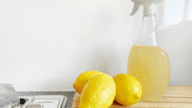Tired of Old House Smell? Here’s How to Send the Stench Packing
- Published on
- 8 min read
-
 Lori Lovely, Contributing AuthorClose
Lori Lovely, Contributing AuthorClose Lori Lovely Contributing Author
Lori Lovely Contributing AuthorLori Lovely edited the Real Estate Home section for the Indianapolis Star and covered the annual Dream Home construction and decor for Indianapolis Monthly magazine. She has written guides for selling houses and more.
-
 Sam Dadofalza, Associate EditorClose
Sam Dadofalza, Associate EditorClose Sam Dadofalza Associate Editor
Sam Dadofalza Associate EditorSam Dadofalza is an associate editor at HomeLight, where she crafts insightful stories to guide homebuyers and sellers through the intricacies of real estate transactions. She has previously contributed to digital marketing firms and online business publications, honing her skills in creating engaging and informative content.
Your house smells… old. There’s just no other way to describe the musty odor that lingers in the air no matter how many times you deep clean your home. So you wonder, how to get rid of old house smell for good?
Old house smell is real — and it’s a huge turn-off for homeowners and guests alike. Thankfully, there are several steps you can take to eliminate the odor. Stick with us, and we’ll teach you how to get rid of old house smell and prevent it from coming back.
mVOCs are the number one culprit of old house smell
Enemy number one when fighting old house smell? Microbial volatile organic compounds (mVOCs). When mold, bacteria, biofilm, and other biological growths decay, they emit mVOCs — the gases we identify as old house smell.
We associate the smell of mVOCs with older homes since older buildings are often more likely to have decaying biological growths. Older homes tend to be darker with less ventilation than modern buildings. Mold and other bacterial growths thrive in dark, damp areas and will begin to emit the old house smell once they begin to decay.
Many homes were built several decades ago, and if you live in one of these homes, there’s a good chance your property has decaying bacterial growth. Even if your home is newer, you may have decaying bacterial growth in damp areas like the crawl space, attic, and basement.
Old house smell may harm your health
According to the Environmental Protection Agency (EPA), the health effects of inhaling mVOCs are largely unknown. However, the organization reports that “exposure to mVOCs has been linked to headaches, nasal irritation, dizziness, fatigue, and nausea,” even if there’s no visible mold growth. mVOCs can also aggravate asthma or allergies. Extreme reactions include disorientation and neurological effects.
Furthermore, some molds produce toxins, such as mycotoxins, which can cause vomiting, diarrhea, acute liver disease, and even death, depending on the level and length of exposure. But mold isn’t the only old house smell source that is bad for your health.
Third-hand smoke can create health issues too. Residual tobacco smoke contamination lingers in rooms long after the cigarette is snuffed out. Nicotine, a toxic particle, can cling to walls and ceilings, while gases can be absorbed by soft fabrics such as upholstery and carpet. These gases can be released back into the air and mixed to form harmful compounds that persist long after the smoking has stopped.
Start eliminating old house smell with a professional mold inspection
A mold inspection is often a good first step to eliminating old house smell. A professional can inspect your home, including the crawl space and basement, for mold so you can identify where the odor is coming from.
For homes smaller than 4,000 square feet, the average cost of mold inspection typically ranges from $300 to $400, while larger homes could cost anywhere from $700 to $1,000.
Mold remediation is a separate cost. Depending on how severe the problem is, remediation can cost anywhere from $700 to $6,000.
Professional mold remediation
Unless the amount of mold is very small, remediation is best left to the professionals. Scrubbing mold with bleach eliminates the mold, but not the spores. A professional uses commercial products to eliminate mold and spores thoroughly.
Mold remediation begins with containment to keep mold spores from spreading to other areas of the house. A professional uses physical barriers or negative air pressure while fans, heaters, and A/C units are off.
Once the professional has contained the area, they remove all water-logged and mold-infested materials, including carpet and drywall, and clean the area with antifungal and antimicrobial products. Next, they vacuum the area using HEPA filtration and sanitize the remediated area.
Prevent mVOCs from returning with these DIY measures
Beyond professional mold remediation, there are other steps you can take to eliminate old house smell and prevent it from coming back. Follow these tips to keep your home’s air fresh and odor-free.
Reduce moisture
Moisture or humidity is the precursor to mold, the source of old house smell. Notorious harbors of humidity include the bathroom, basement, crawl spaces, or anywhere with poor ventilation and a source of moisture.
To prevent mold, maintain your home’s humidity level between 40% and 55%. If you feel “sticky” in the summer or notice condensation on the windows in the winter, you’ll know there’s too much humidity in the air. You can check the humidity level with a humidity monitor, also known as a hygrometer.
Tips to lower humidity:
- Use a dehumidifier to remove excess moisture from the air and help start the drying process. Place them in dark, dank corners of your home to keep the indoor humidity level below 55%.
- Improve ventilation by opening the windows periodically and installing efficient exhaust fans and ceiling fans.
- Air out the bathroom after you shower.
- Run the air conditioner in the humid summer months. Be sure to clean the filters for optimal performance.
- Wrap pipes and increase air temperature to prevent condensation.
- Add houseplants to soak up some of that humidity.
- Add soffit vents in your attic to increase airflow and reduce humidity by allowing air to enter the attic along the eave’s underside.
Look for leaks
Mold and mildew grow in dark areas where moisture is present, so it’s imperative to look for leaks. The first step is to check kitchen and bathroom pipes for leaks and make the necessary repairs. Then, inspect the common culprits, such as toilets, washing machines, dishwashers, water heaters, sinks, and bathtubs.
Beyond puddling water or damp walls, you can use tools like a surface thermometer, damp meter, or hygrometer to detect hidden leaky pipes and excess moisture.
Clean out the drains
Dirty drains are a hot spot for bacteria and mold, which cause old house smells. To clean your drains, pour a cup of baking soda down the drain, followed by a cup of vinegar. After half an hour, rinse the drain with hot water. If the smell remains, it may be related to a sewer problem. In this case, you’ll need to call a professional.
Clean upholstered furniture
Older upholstered furniture may harbor mVOC-emitting biological growths, especially if they’re located in humid rooms or storage areas.
To eliminate odor from upholstered furniture, start with a surface clean. Sprinkle baking soda on the furniture and let it sit for 15 minutes to 12 hours before vacuuming clean. You’ll also need to use antibacterial products to eliminate mold growth altogether. Be sure to test the product on a small, less visible area of your furniture to ensure the product doesn’t leave a stain.
If the furniture continues to smell like an old house, hire a professional for a deeper cleaning. Contractors typically steam-clean upholstery and apply a deodorizer to remove dirt, allergens, and smells.
If professional cleaning doesn’t remove the odor, you’ll need to deconstruct the furniture to replace cushions riddled with mold or throw the pieces out.
Scrub hard surfaces
Mold spores are not visible to the naked eye, so it’s necessary to take precautionary measures in damp areas where air doesn’t circulate. Because wood absorbs and retains water, it’s a natural host for mold. That’s why it’s important to clean baseboards, trim, and wood furniture.
Use products specifically formulated to eliminate mold. Alternatively, you can make a DIY cleanser by dissolving half a cup of Borax in 32 ounces of hot water and adding two cups of distilled white vinegar and 16 ounces of hydrogen peroxide to the mix.
Change your air filters and clean your ducts and vents
A general rule of thumb is to change 1-inch to 2-inch filters every 1 to 3 months and 3-inch to 4-inch filters every 6 to 9 months. However, you may need to change your filters sooner depending on the quality of your filters, the number of people and pets in your home, and common household allergens.
Signs you need to change your filters include noticeable increases in energy bills and dust settled around the air vents. For best results, use HEPA air filters made of fine mesh to trap harmful particles such as mold, pet dander, pollen, dust mites, and smoke.
Beyond air filters, the air ducts themselves can host mold and readily spread miasma throughout your house. If you suspect your HVAC system could use some cleaning, hire a professional to service the system. The average cost for HVAC maintenance is $250, typically ranging from $100 to $650.
Invest in air purifiers with carbon filters
Air purifiers with carbon filters like the Alen BreatheSmart provide ongoing protection against mVOCs. Activated charcoal and carbon filters pull odor-causing chemicals from the air and trap them. The Azuna Anti-Microbial Odor Eliminator uses carbon filters to remove mold, mildew, fungus, and bacteria at a microscopic level.
You can also hang air-purifying bags around the house. Lasting up to two years, bags of activated charcoal help prevent mold, mildew, and bacteria by absorbing excess moisture and removing allergens, odors, and other pollutants.
Other odors that may contribute to old house smell
While mVOCs are the main source of old house smell, other odors may contribute to your home’s unpleasant scent. Here’s what you can do to eliminate the following odors:
Cigarette smoke
Smoke is “captured” by soft surfaces, particularly fabric. Here’s what you can do to rid your home of that cigarette stench:
- Wash items in cold water with two cups of vinegar.
- Take items that can’t go in the washer (like drapes) to the dry cleaners.
- Sprinkle baking soda or commercial deodorizing products on rugs, carpets, and furniture. After waiting 30 to 60 minutes, vacuum.
- Shampoo carpets with a carpet cleaner.
- Clean hard furniture with a vinegar spray (unless the furniture’s finish is delicate).
- Wash the walls and ceiling with a vinegar and water solution. Mix two cups of vinegar, one cup of Borax, and 16 ounces of hydrogen peroxide in a bucket of hot water.
- Paint the walls and ceilings for a fresh smell and look.
Pet odors
As much as you love your furry friends, they may be contributing to your home’s foul scent. Keep your pets and remove their odors with these tips:
- Vacuum carpets and furniture to remove pet fur and dander. For best results, purchase a vacuum designed to suck up fur like the Hoover WindTunnel 3 High-Performance Pet Bagless Corded Upright Vacuum.
- Use the baking soda solution to deep clean pet stains. If you can’t locate them easily, a black light will point them out. For resistant stains, use Hoover Platinum Collection Professional Strength Instant Stain Remover. A hardwood-safe enzymatic cleaner can deodorize pet urine that has seeped into hardwood floors.
- Shampoo your carpet to remove deep stains that resist simple cleaning measures. Rent a carpet cleaner machine from the local grocery or hardware store. Big-box chains like Lowes rent carpet cleaners for as little as $30 a day. Or you may prefer hiring a professional carpet cleaning company to do the work for you.
- Wash pet beds and blankets in hot water. If that doesn’t work, wash again using an enzymatic cleaner like Rocco and Roxie or MisterMax.
- Keep specialty pet cleaning items on hand for regular cleaning.
- Buy kitty a litter box robot to contain odors.
Keep your home smelling fresh and void of old house smell
Once you’ve tackled the cause of old house smell at the source, make an effort to boost the fresh, clean aroma in your home — especially if you’re selling your home.
Simple smells boost sales, with citrus helping increase buyers’ perceived property value. So cut a few oranges or lemons before a showing. Buyers and guests prefer neutral and natural scents over plug-in air fresheners, sprays, essential oils, and strongly scented candles.
You can also leave an open box of baking soda in concealed spots to absorb odors. For persistent smells, choose all-natural commercial products like FreshWave or DampRid that absorb smells and trap excess moisture in the air.
Above all, clean — regularly, seasonally, and most importantly, before a buyer comes to view your house. For expert guidance on preparing your home for sale, connect with a local real estate agent. Use our Agent Match tool to find the best agents in your area today.
Header Image Source: (Dmitry Mashkin / Unsplash)






